|
|||||||||||||||||||
|
|
|||||||||||||||||||
|
|
The HUT/Astro Photo Gallery
In addition to the large volume of astronomical data gathered during the Astro missions, the astronauts also obtained many spectacular photographs of the earth, the telescopes in the payload bay, and themselves! This page provides you with quick access to some of the best images obtained during the Astro missions.
For a more extensive selection of images from both Astro-1 and Astro-2, please visit the Historical Image Archive page.
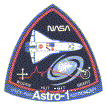 Astro-1 Mission Patch
Astro-1 Mission PatchThe Astro-1 Mission Patch shows a stylized shuttle with the telescopes in the payload bay. Graphics below the shuttle are symbolic of the specialties of each of the four telescopes that made up the scientific payload. (Astro-1)
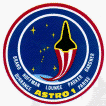 Astro-1 Crew Patch
Astro-1 Crew Patch
The Astro-1 Crew Patch was designed by the crew. It shows a stylized space shuttle taking off from earth, with the constellation Orion rising in the background. This constellation was high in the night sky for the December 1990 launch, and represented the astronomical nature of the mission.(Astro-1)
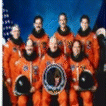 Astro-1 Crew Photo (Official)
Astro-1 Crew Photo (Official)
The five astronauts and two payload specialists that flew NASA's STS-35 mission aboard Columbia in 1990 December in their formal crew portrait. Astronaut Vance D. Brand, center-front and holding STS-35 insignia, made his fourth flight in space and his third STS flight, and served as mission commander. He is flanked on the front row by Pilot Guy S. Gardner and Mission Specialist (MS) John M. Lounge. On the back row (left to right) are MS Robert A.R. Parker, Payload Specialist (PS) Ronald A. Parise, MS Jeffrey A. Hoffman, and PS Samuel T. Durrance. The crewmembers are wearing their orange launch and entry suits. (Astro-1)
NASA Photo ID: STS035(S)002
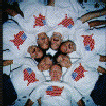 Astro-1 Crew Photo (On-orbit)
Astro-1 Crew Photo (On-orbit)
STS-35 crewmembers, wearing TAKE PRIDE IN AMERICA T-shirts, pose on Columbia's middeck for on-orbit crew portrait. Clockwise from the bottom center are Commander Vance D. Brand, Mission Specialist (MS) Robert A.R. Parker, Payload Specialist (PS) Ronald A. Parise, MS Jeffrey A. Hoffman, Pilot Guy S. Gardner, MS John M. Lounge, and PS Samuel T. Durrance. (Astro-1)
NASA Photo ID: STS035-503-007
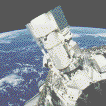 Astro-1 Telescopes in Payload Bay
Astro-1 Telescopes in Payload Bay
The Astro Observatory is seen here in a daylight pass during Astro-1 with the earth limb and the blue Pacific Ocean as a dramatic backdrop. HUT is front and center, with the WUPPE telescope to the right. The silver tube to the left is the ASTROS star tracker. The telescopes are attached to the Spacelab Instrument Pointing System (silver ring and gimbal below the telescopes). (Astro-1)
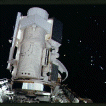 Astro-1 Telescopes in Payload Bay at night.
Astro-1 Telescopes in Payload Bay at night.
STS-35 Astro-1 telescopes, in their on-orbit operating configuration, are documented in the payload bay of Columbia. To the right of the Astro-1 payload is the constellation Orion. The three ultraviolet telescopes are mounted and precisely aligned on a common structure, called the cruciform, that is attached to the instrument pointing system (IPS). Visible here are the star tracker (silver cone at the far left), the Hopkins Ultraviolet Telescope (HUT), and the Wisconsin Ultraviolet Photo-Polarimeter Experiment (WUPPE) (to the right of HUT). Since the photo was taken during orbital night, the payload is being illuminated only by scattered light from the nearly full moon. (Astro-1)
NASA Photo ID: STS035-28-022
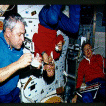 Astro-1 Crew eat on the middeck
Astro-1 Crew eat on the middeck
Enjoying a meal on the middeck of Columbia, are STS-35 Mission Specialist Robert A.R. Parker (foreground), Payload Specialist Ronald A. Parise (center), and Commander Vance D. Brand. Parker spoons up bite from his food container as Parise lets a spoonful freefloat into his open mouth and Brand balances his meal tray assembly. The forward lockers, the shuttle treadmill, and the starboard side sleep station are seen in the view.(Astro-1)
NASA Photo ID: STS035-09-002
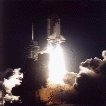 Astro-2 Launch Photo
Astro-2 Launch PhotoThe dramatic night launch of Astro-2 (STS-67) aboard the space shuttle Endeavour on 1995 March 2. The launch was planned for night in order to position the orbit to maximize night viewing time for the telescopes. (Astro-2)
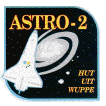 Astro-2 Mission Patch
Astro-2 Mission PatchThe Astro-2 mission patch shows a shuttle outline with a graphic representation of the telescopes in the payload bay. In the background is a star field and a spiral galaxy, indicative of the astronomical nature of the mission. (Astro-2)
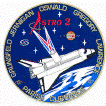 Astro-2 Crew Patch
Astro-2 Crew Patch
This patch depicts the Astro-2 telescopes in Endeavour's payload bay. The three sets of rays, diverging from the telescope on the patch atop the Instrument Pointing System correspond to the three Astro-2 telescopes, HUT, UIT, and WUPPE. The telescopes are aligned to simultaneously view the same astronomical object, as shown by the convergence of the rays on the NASA symbol. Astro-2's celestial targets include the observation of planets, stars, and galaxies as shown in the design. The two small atoms represent the search in the ultraviolet spectrum for the signature of primordial helium in intergalactic space left over from the Big Bang. This patch was designed by the crew of STS-67. (Astro-2)
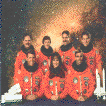 Astro-2 Crew Photo (Official)
Astro-2 Crew Photo (Official)
Official STS-67 preflight crew portrait. In front are astronauts (left to right) Stephen S. Oswald, mission commander; Tamara E. Jernigan, payload commander; and William G. Gregory, pilot. In the back are (left to right) Ronald A. Parise, payload specialist; astronauts Wendy B. Lawrence, and John Grunsfeld, both mission specialists; and Samuel T. Durrance, payload specialist. Dr. Durrance is a research scientist in the Department of Physics and Astronomy at Johns Hopkins University, Baltimore, Maryland. Dr. Parise is a senior scientist in the Space Observatories Department, Computer Sciences Corporation, Silver Spring, Maryland. Both payload specialists flew aboard the Space Shuttle Columbia for the STS-35/Astro-1 mission in December 1990. (Astro-2)
NASA Photo ID: STS067(S)002
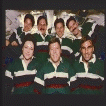 Astro-2 Crew Photo (On-orbit)
Astro-2 Crew Photo (On-orbit)
The STS-67/Astro-2 crew members pose for their traditional inflight portrait on the aft flight deck of the Earth orbiting Space Shuttle Endeavour. Left to right in the front are astronauts Tamara E. Jernigan, payload commander; Steven S. Oswald, mission commander; and William G. Gregory, pilot. Left to right on the back row are astronaut Wendy B. Lawrence, flight engineer; payload specialists Ronald A. Parise and Samuel T. Durrance; and John M. Grunsfeld, mission specialist. (Astro-2)
NASA Photo ID: STS067-317-002
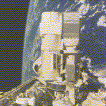 Astro-2 Telescopes in Payload Bay#1
Astro-2 Telescopes in Payload Bay#1
The Astro-2 payload is seen in this daylight view from Astro-2. HUT is seen on the left in this view, and WUPPE is on the right. The white cylinder in the foreground, known as the "igloo", houses some of the payload's electronics. Two "Get-Away-Special" cannisters are seen at left, mounted in the payload bay. (Astro-2)
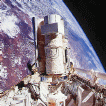 Astro-2 Telescopes in Payload Bay#2
Astro-2 Telescopes in Payload Bay#2
This spectacular view shows the Astro-2 package in Endeavour's payload bay as the shuttle orbits high above the Australian desert. Scanned from a slide, this one is great! (Astro-2)
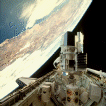 Astro-2 Telescopes in Payload Bay #3
Astro-2 Telescopes in Payload Bay #3
The Astro-2 telescopes drift over the western coast of Chile. The WUPPE telescope is in the foreground, and HUT is toward the back left in this view. The trio of star trackers on the right provides pointing information to the Instrument Pointing System. Although not directly visible, some of the finest ground-based astronomical observatories, including Cerro Tololo Interamerican Observatory, Las Campanas Observatory, and the European Southern Observatory, are in this picture.
This picture was scanned from a slide and is an extremely good
quality picture.
Note: This picture is a 617Kb JPEG file (Astro-2)
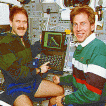 Endeavour Astronauts on Aft Flight Deck
Endeavour Astronauts on Aft Flight Deck
This photo shows astronauts John Grunsfeld and Sam Durrance on the Aft Flight Deck of Endeavour during Astro-2. The windows at the top edge of the photo look out onto the Astro telescopes in the payload bay. The computer screen shows the HUT spectrum of a white dwarf calibration star observed during the mission. (Astro-2)
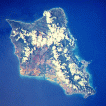 Views from Space#1: Oahu, Hawaii
Views from Space#1: Oahu, Hawaii
This is a full view of the island of Oahu in the Hawaiian chain of islands. Oahu's volcanic origins are hinted at by the volcanic crater at Diamond Head, clearly visible on the southern shore. The city of Honolulu stretches from Diamond Head to the inlet of Pearl Harbor. Honolulu's large international airport can be seen off the shore. The dense forestation of the highlands is visible below the cloud cover, and waves can be seen breaking along the northern shore where famous surfing beaches, such as Pipeline, are found. Scanned from a slide. (Astro-2)
NASA Photo ID: STS067-708B-057
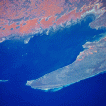 Views from Space#2: Shark Bay, Western Australia
Views from Space#2: Shark Bay, Western Australia
An oblique view of the Shark Bay complex from the east. Hamelin Pool at the center of the photo and Shark Bay proper are separated from Freycinet Estuary and Denham Sound by the Peron Peninsula. These, in turn, are separated from the Indian Ocean by Edel Land Peninsula and Dirk Hartog Island. This arid western coast of western Australia is very sparsely populated, but a few roads can be seen. A complex set of lime-sediment shoals and tidal passes forms the Disappointment Reach shallows. Some red, land-derived mud does make its way into the inter tidal zone along the coast north of the reach. The clouds of light-colored water in Shark Bay and Denham Sound may either be lime sediment, perhaps precipitated from sea water or a plankton bloom. (Scanned from a slide.) (Astro-2)
NASA Photo ID: STS067-730A-048
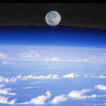 Views from Space#3: Moonrise
Views from Space#3: Moonrise
Astro-1 astronauts snapped this picture as part of a sequence showing the full moon rising over the earth's limb shortly before they returned to earth. Thunderheads in the foreground give this image an interesting 3-D effect. (Scanned from a slide.) (Astro-1)
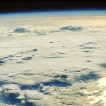 Views from Space#4: Thunderstorms
Views from Space#4: Thunderstorms
Oblique lighting and a zoom lens allow this Astro-1 earth view to show the dramatic 3-D relief of a large field of thunderclouds. The largest anvil head clouds top out at some 60,000 ft. (Scanned from a slide.) (Astro-1)
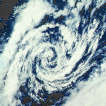 Views from Space#5: Southern Storm
Views from Space#5: Southern Storm
Looking in many respects like one of the spiral galaxies observed by the telescopes, this dramatic picture of a storm in the South Pacific was snapped by Astro-2 astronauts. (Scanned from a slide.) (Astro-2)
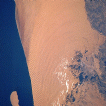 Views from Space#6: Namib Desert, Western Africa
Views from Space#6: Namib Desert, Western Africa
This view shows the huge dune patterns created by the prevailing winds from the southwest (lower left) in this image of the coast of Angola. A few puffy clouds, with their attendant shadows, provide an interesting element of depth to this dramatic earth view. (Scanned from a slide.) (Astro-1)
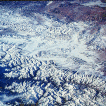 Views from Space#7: Himalayas from Above
Views from Space#7: Himalayas from Above
Astronauts report that the region near the Himalaya mountains is one of the only places on earth where relief is visible to the unaided eye. This image shows this effect dramatically, with the snow-capped peaks visible in all their glory. (Astro-2)
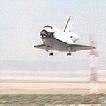 ASTRO2: Approach of Endeavour for Landing
ASTRO2: Approach of Endeavour for Landing
The Space Shuttle Endeavour approaches runway 22 at Edwards Air Force Base. Landing occurred at 1:46 p.m. (EST), March 18, 1995. (Astro-2)
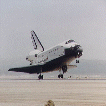 ASTRO2: Touchdown of Endeavour
ASTRO2: Touchdown of Endeavour
The Space Shuttle Endeavour, after completing a mission of almost 17 days duration in space, touched down on runway 22 at Edwards Air Force Base in southern California. Landing occurred at 1:46 p.m. (EST), March 18, 1995. In this photo the nose gear is still in the air as the orbiter touches down. (Astro-2)
NASA Photo ID: STS067(S)053
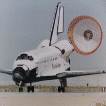 Drag Chute deploys on Endeavour
Drag Chute deploys on Endeavour
The drag chute is fully deployed in this view of the Space Shuttle Endeavour as it completes the 17 day ASTRO-2 mission. (Astro-2)
NASA Photo ID: STS067(S)054
|
|
|




 Follow Us
Follow Us